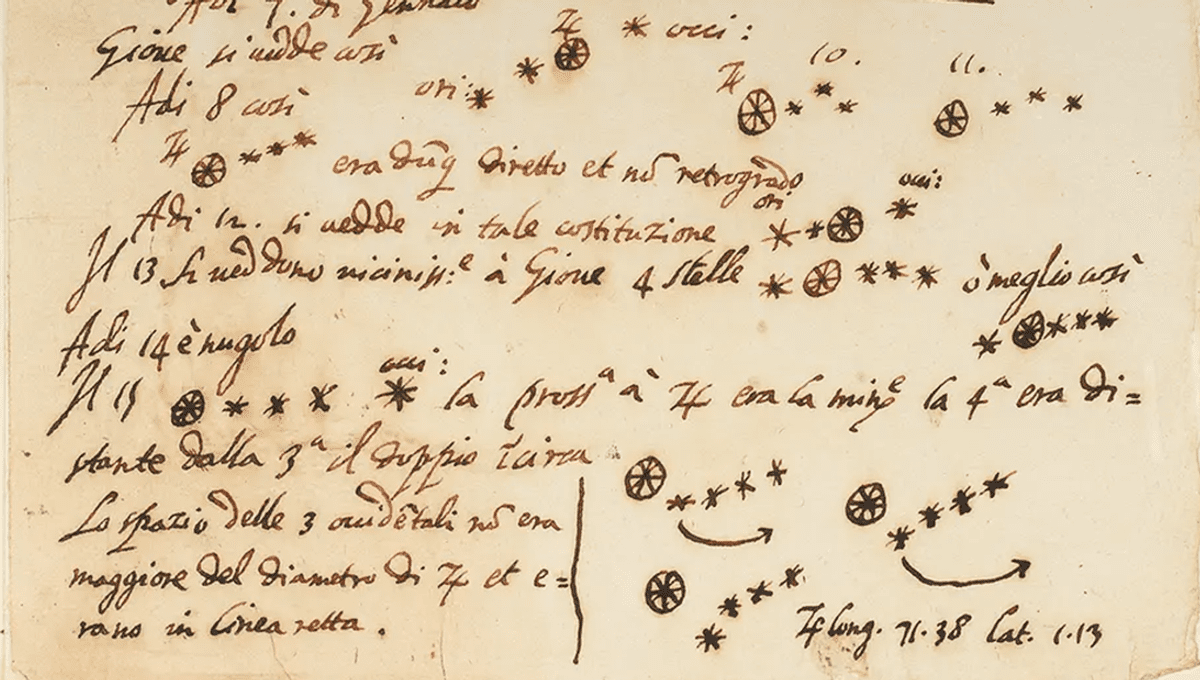
Since 1938, the University of Michigan Library has proudly displayed what they thought to be a 1609 manuscript, penned by Galileo Galilei himself. Unfortunately, following an investigation by a Georgia State University professor of history, the manuscript turns out to be an impressive forgery, created hundreds of years after Galileo’s death.
The one-page document contained the draft of a letter to accompany a presentation by Galileo of a recently-built telescope in 1609. At the bottom of the paper, much more significant if it weren’t forged (which it is), were notes and sketches, thought to be observations by Galileo of the moons of Jupiter from January 7–15, 1610.
The manuscript was first seen by the wider public in May 1934, after the belongings of a recently-deceased collector – Roderick Terry – were auctioned off. Another collector – Tracy McGregor – bought the manuscript, before bequeathing it to the University of Michigan in 1938 after his own death. Since then, the manuscript has been a “jewel” in the library’s collection, until a historian informed them of the manuscript’s inauthenticity.
During his investigations, Nick Wilding, a historian who gained attention after he exposed a previous forgery of Galileo’s 1610 book Sidereus Nuncius, asked the library a number of questions about the manuscript, including about the dating of the paper and its watermark. During the time of the hand press, the makers of paper often added distinct watermarks to their work. While primarily to help identify it as theirs, these watermarks help historians to date paper, as well as where it was made.
The manuscript – now known to be a forgery – contains the monogram of the paper’s maker, “A.S.”, while the production location is labeled “BMO”, referring to Bergamo, Italy. The mark “BMO” has not been seen in paper from any time before 1770, long after Galileo’s death, before becoming quite common.
A second, similar forgery was found in the Morgan Library and Museum in New York City, which has been dated to 1790. The Michigan Library’s copy was authenticated by Archbishop Maffi in 1930, after comparing it to two other documents by Galileo. These documents turned out to also be frauds, donated by notorious 20th-century forger Tobia Nicotra.
“Wilding concluded that our Galileo manuscript is a 20th-century fake executed by the well-known forger Tobia Nicotra,” the library wrote of the investigation. “After our own experts studied his most compelling evidence – about the paper and provenance – and reexamined the manuscript, we agreed with his conclusion.”
Nicotra forged an excellent reputation for himself as a forger and got several forged manuscripts into the Library of Congress. At the time of his arrest in the early 1930s, police found a series of fake Abraham Lincoln autographs in his possession, as well as others from Christopher Columbus, Martin Luther, Michelangelo, and Leonardo Da Vinci.
“We’re grateful to Professor Wilding for sharing his findings,” the library said in a statement. “And are now working to reconsider the manuscript’s role in our collection.”
Source Link: 1609 Galileo Manuscript Turns Out To Be Work Of Notorious 20th Century Forger